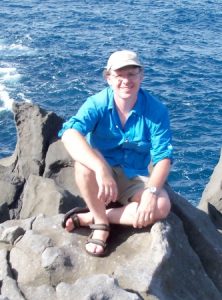
Topic: Ethnobotany and power across the African Atlantic
Abstract:
In this presentation I show the social and historical contexts of two plant species, Dracaena fragrans and Cordyline fruticosa, in West Central Africa and the Eastern Caribbean. Both plants are simultaneously property rights institutions and symbols of peaceful and orderly relationships in both regions. I present the stories of these plants in Cameroon and St. Vincent to demonstrate how these particular plants are keystone species of two very different social-ecological systems.
Biography:
My interest in anthropology began at Harvard in 1984. I decided to major in anthropology with an archaeological focus because it was about as far as I could get from the suburban lifestyle I had known until then. I did a lot of work on the reconstruction of symbolic systems from the archaeological record of mute stones and bones. After I graduated in 1988, I joined the Peace Corps as a water technician (based largely on my experiences in student theatre as a set designer). Just three weeks after commencement, a Peace Corps jeep dropped me and a backpack at my homestay in the village of Kinungi, Kenya. I adjusted to my new home with the Macharia family over that first weekend by learning to cook chapattis and to milk a cow without getting the Vaseline on my hands into the milk. I didn’t speak any Swahili yet, and my family didn’t speak much English. It was a pretty steep learning curve for all of us.
Peace Corps posted me to the town of Wundanyi, in the Taita Hills of southeastern Kenya. It was a beautiful place – 8000’ high rocky peaks with shrouds of cloud and rainforest, waterfalls everywhere, and miles of dirt roads that I got to know very well. My job was helping village water project committees to design and get funding for water pipelines. I taught myself enough hydraulics and survey techniques to do my job, and by the time I left in 1990 I had 11 designs finished and 2 projects funded and built. Peace Corps was an amazing experience that didn’t fit easily into the dichotomy of good and bad. All of the high points were exhilarating; all of the low points were devastating. It made me more intensely alive than I had ever been, and it thoroughly transformed me. But there was a problem – the two pipelines I had finished fell apart within a year after I left, because too many people installed illegal taps in the main pipeline. Water pressure fell, and the management committee fell apart. After I received letters about this from my friends in Taita, my innate stubbornness pushed me to understand why. What is ‘environmental management,’ anyway? How do African ideas of management differ from those of development planners? These questions sent me to grad school to pursue a Ph.D. in anthropology. I started working toward my degree in 1992, got married and moved to Vermont in 1995, did field research in Tanzania in 1997-1998, and finished my Ph.D. in 2001.
My interest in resource management expanded into a theoretical interest in how localized relationships between the cultural and biophysical worlds become transformed by their incorporation into the global economic and political system. This topic requires interdisciplinary approaches because environmental change lies at the intersection of symbolic and material processes. African agriculture, for example, often merges mundane issues like soil moisture and crop yields with metaphysical concerns about gender relations and cosmology. Understanding the causes and consequences of environmental change therefore demands a methodological holism that can draw on perspectives from the social and the natural sciences. When combined, sociocultural anthropology, environmental history, biogeography, and political ecology can bridge the artificial dichotomy of nature and culture to reveal the instability and complexity of human-land relationships. By conceptualizing human ecology as a historical process characterized more by change than equilibrium, this perspective on global environmental change can explore international relations, regional political economies, and local understandings of land use in the same intellectual framework. All of these levels of analysis are linked by nested social relations of power.
I have engaged these issues through fieldwork on agriculture, community development, and land management in the North Pare Mountains of Tanzania in 1997-1998, 2004, and 2006. My work has focused on development agency efforts to manage resources, and how those forms and meanings of conservation interact with, and often contradict, indigenous ways of doing things. I have explored this topic through irrigation management and soil and water conservation practices, but most of my recent work has involved theory-building for understanding the social and ecological contexts of sacred groves in Africa. My current work concerns the thorny issue of how the key concept of power varies cross-culturally. I argue that a more anthropological political ecology must explore how environmental management in the tropics typically leads to conflict because of contradictory assumptions about power at personal, institutional, and symbolic levels of social action.
My wife Kristina Simmons and I live in Cornwall with our daughter Gaia, son Kieran, and various critters.
